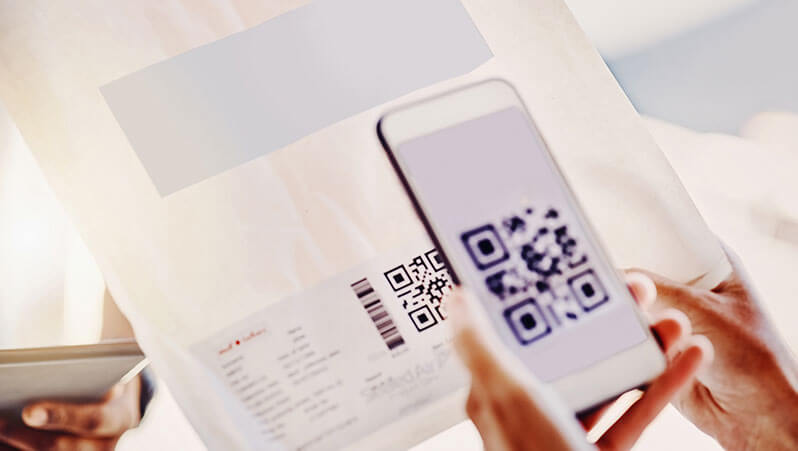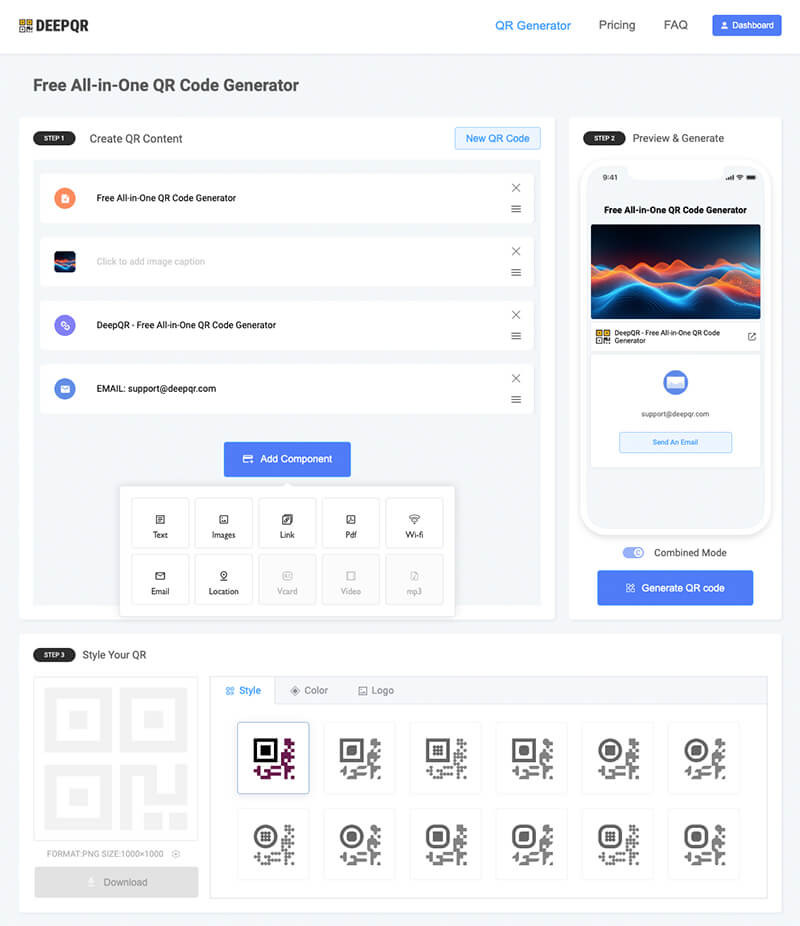What is the difference between static and dynamic qr codes?
- Static QR codes cannot be modified once generated, while dynamic QR codes can be updated at any time.
- Static QR codes are free and permanently valid, but dynamic QR codes incur usage fees due to server costs.
- Static QR codes do not require internet connectivity, whereas dynamic QR codes must be scanned online.
- Static QR codes can only store text-based information such as text, WiFi details, or contact information. Dynamic QR codes can store any type of content.
- Static QR codes cannot track scan statistics, while dynamic QR codes can provide scan tracking and analytics.
What is a Static QR Code?
A static QR code is a technology that encodes information directly into the QR code image, making the information fixed and unchangeable after generation. This type of QR code does not rely on any external server to store or decode the information; all data is embedded within the QR code itself. Therefore, static QR codes can be used without internet support, allowing users to instantly access the information contained within the QR code upon scanning.
One of the primary characteristics of static QR codes is that the information is fixed and cannot be modified. If any changes are needed, a new QR code must be generated. This makes static QR codes ideal for simple and unchanging information scenarios, such as URLs or text content. Since static QR codes do not require server dependencies, the cost of creating and using them is relatively low, making them suitable for large-scale, rapid promotion and application.
What is a Dynamic QR Code?
Dynamic QR codes are a more flexible and powerful type of QR code technology. The key difference between dynamic and static QR codes is that the information within dynamic QR codes can be updated and changed at any time. Dynamic QR codes do not directly contain information; instead, they store a short URL or identifier that, when scanned, is resolved and redirected by a server to display the latest information. This means that no matter how long the QR code has been generated, as long as the information on the server is updated, the user will always receive the most current information upon scanning the QR code.
A significant feature of dynamic QR codes is the ability to update information, which gives them a distinct advantage in many applications. For example, businesses can use dynamic QR codes to adjust promotional content in real time without needing to create new QR codes. Additionally, dynamic QR codes support detailed scan tracking and analytics, enabling businesses to monitor scan statistics, such as the number of scans, time, and location, thereby providing valuable insights for marketing strategies.
Due to their reliance on servers for information resolution, dynamic QR codes require an internet connection for use and have higher creation and maintenance costs compared to static QR codes. However, their flexibility and robust functionality make them particularly effective in complex scenarios like marketing, user surveys, and event registrations.
Advantages and Disadvantages of Static QR Codes
Static QR codes, as a fundamental and widely used QR code technology, have a set of advantages and disadvantages that suit different use cases.

Advantages:
Static QR codes are straightforward to generate and use. Users simply encode the desired information into the QR code to create a static QR code. This process does not require complex technical support and can be completed using online tools or related software, making it ideal for quick creation and application.
Additionally, static QR codes do not need server support. This means that once generated, static QR codes can exist independently without relying on network or external servers for information resolution and display. Users can scan the QR code and directly read the embedded information, which is convenient and quick.
Lastly, the cost of creating static QR codes is low. Since there is no need for server maintenance or network support, the expense of generating a static QR code is minimal, making it suitable for large-scale promotion and application, such as product labels, business cards, and simple links.
Disadvantages:
However, static QR codes also have their drawbacks. First, the information cannot be changed. Once generated, the information within the QR code is fixed. If updates are needed, a new QR code must be created, which is not flexible for scenarios that require frequent content updates.
Moreover, static QR codes have limited data capacity. Since all information is embedded within the QR code image, large amounts of content may not fit entirely, restricting the use of static QR codes in complex scenarios.
Advantages and Disadvantages of Dynamic QR Codes

Advantages:
One notable advantage of dynamic QR codes is that the information can be updated at any time. Because the content of dynamic QR codes is resolved by a server, simply updating the information on the server allows users to receive the latest content upon scanning the QR code. This is especially important for scenarios requiring frequent updates, such as promotional activities, product information, and time-sensitive announcements.
Secondly, dynamic QR codes support large amounts of data and complex applications. Since the information is stored on a server and the QR code itself is just an identifier, it can handle and display a large amount of complex information, such as multimedia files, user forms, and interactive content. This makes dynamic QR codes more versatile and applicable to a wider range of scenarios compared to static QR codes.
Finally, dynamic QR codes enable scan statistics and tracking. Using the server backend system, detailed records of each scan, including time, location, and frequency, can be generated, providing comprehensive analysis reports. This is particularly useful for marketing and user behavior analysis, as businesses can optimize and adjust their strategies based on this data.
Disadvantages:
Dynamic QR codes also have some drawbacks to consider. First, they require server support. The information resolution and display of dynamic QR codes depend on servers, which means that stability and network connectivity must be ensured during creation and use. Otherwise, users may not be able to correctly access the information within the QR code.
Additionally, the cost of dynamic QR codes is relatively high. Due to the need for server maintenance and network traffic support, creating and operating dynamic QR codes is more expensive than static QR codes. For some small businesses or individual users, this may be a consideration.
Comparative Application Scenarios
Static and dynamic QR codes each have unique advantages in different application scenarios. The choice between the two often depends on specific needs and use cases.
Typical Application Scenarios for Static QR Codes:
Business Cards: Static QR codes are ideal for electronic business cards. Users can embed their contact information, company details, etc., into the QR code, allowing quick saving of these details upon scanning. This method is simple, convenient, and suitable for long-term use.
Product Labels: Using static QR codes on product packaging or labels can provide basic product information, such as production date, shelf life, and usage instructions. Consumers can quickly access this information by scanning the QR code, making it practical and useful.
Simple Links: For simple links like company websites or social media profiles, static QR codes are also very appropriate. Users can scan the QR code to directly navigate to the specified website or page, saving the hassle of manually entering URLs.
Typical Application Scenarios for Dynamic QR Codes:
Marketing and Promotion: Dynamic QR codes offer significant advantages in marketing. Businesses can use dynamic QR codes to publish and update promotional information, discount coupons, etc., ensuring consumers receive the latest activity content. Through backend data analysis, promotional effectiveness can be tracked, and marketing strategies adjusted accordingly.
Event Registration: For various event registrations or information submissions, dynamic QR codes provide a flexible solution. Users can scan the QR code to fill out registration forms or submit information, while businesses can update event details or forms at any time to ensure real-time accuracy.
Dynamic Links: Dynamic QR codes are particularly suitable for scenarios requiring frequent updates to link content, such as publishing the latest news, blog posts, or video content. By updating the server information, users can access the latest content upon each scan, ensuring timely information delivery.
How to Choose the Right Type of QR Code
Choosing the appropriate type of QR code requires a comprehensive consideration of specific application needs, costs, and technical support. Here are some guiding principles to help you decide between static and dynamic QR codes.
Choosing Based on Application Needs:
Fixed Information That Does Not Need Modification: If your use case involves fixed information that does not require frequent updates, then static QR codes are an ideal choice. For example, contact details on business cards or production dates and instructions on product labels are typically unchanging. Using static QR codes can save costs and offer a straightforward creation and usage process.
Need for Information Updates or Data Tracking: If your application requires frequent information updates or data tracking, then dynamic QR codes are more suitable. For instance, in marketing promotions where discount information needs to be continuously updated or where detailed scan data collection and analysis are required. The flexibility and analytics capabilities of dynamic QR codes can meet these needs, ensuring real-time information and providing detailed reports.
Cost and Technical Support Considerations:
Static QR Codes: Static QR codes have lower creation and usage costs because they do not require server support. They can be generated once without the need for ongoing maintenance or updates, making them ideal for personal users or small businesses with limited budgets. Additionally, static QR codes do not require internet connectivity, allowing users to directly read the information within the QR code.
Dynamic QR Codes: Dynamic QR codes have higher costs because they require server support for information resolution and updates, along with continuous technical maintenance. Despite the higher cost, dynamic QR codes offer greater value in scenarios requiring frequent updates and data tracking. Businesses with sufficient budgets can invest in dynamic QR code solutions for more efficient information management and user interaction.
Recommended Tools for Generating Static and Dynamic QR Codes
Choosing the right tools for generating static and dynamic QR codes can significantly improve efficiency and user experience. Here are some recommended tools for each type of QR code.
Recommended Tools for Generating Static QR Codes:
1. QR Code Generator by GOQR.me:
GOQR.me is a user-friendly online QR code generator that allows users to quickly create various types of static QR codes, including URLs, text, business cards, and more. Simply input the relevant information to generate and download the QR code. It supports multiple QR code output formats, making it suitable for personal users and small businesses.
2. QRStuff:
QRStuff offers a feature-rich QR code generation platform supporting various static QR code types such as URLs, phone numbers, SMS, WiFi, and more. Users can customize colors, sizes, and other options to create personalized QR codes. The tool is easy to use and generates QR codes quickly, fitting a wide range of applications.
3. Unitag QR Code Generator:
Unitag provides a QR code generator that supports multiple static QR code types and allows for extensive customization, including colors, shapes, and logos. This tool is ideal for users needing high customization, enabling the creation of QR codes that match brand images through a simple interface.
Recommended Tools for Generating Dynamic QR Codes:
1. DeepQR:

DeepQR is a tool focused on generating and managing dynamic QR codes. Its unique feature is the ability to add text, images, links, and other components to a single QR code. Users can create various customized dynamic QR codes and update content in real-time through DeepQR. The tool also offers detailed scan statistics and data analysis, helping users track QR code usage and effectiveness. DeepQR is easy to use and provides comprehensive features, making it suitable for marketing, event registration, dynamic links, and more.
2. Bitly:
Bitly is not just a link shortener but also offers dynamic QR code generation and management. Users can create dynamic QR codes with Bitly, update the content in real-time, and perform scan tracking and analysis. This tool is particularly suitable for marketing and data tracking applications.
3. QR Code Generator Pro:
QR Code Generator Pro is a professional tool for generating dynamic QR codes, offering various services for generating and managing QR codes. Users can update QR code content in real-time, monitor scan data, and generate detailed analysis reports. This tool is suited for enterprise users needing complex applications and data tracking.
